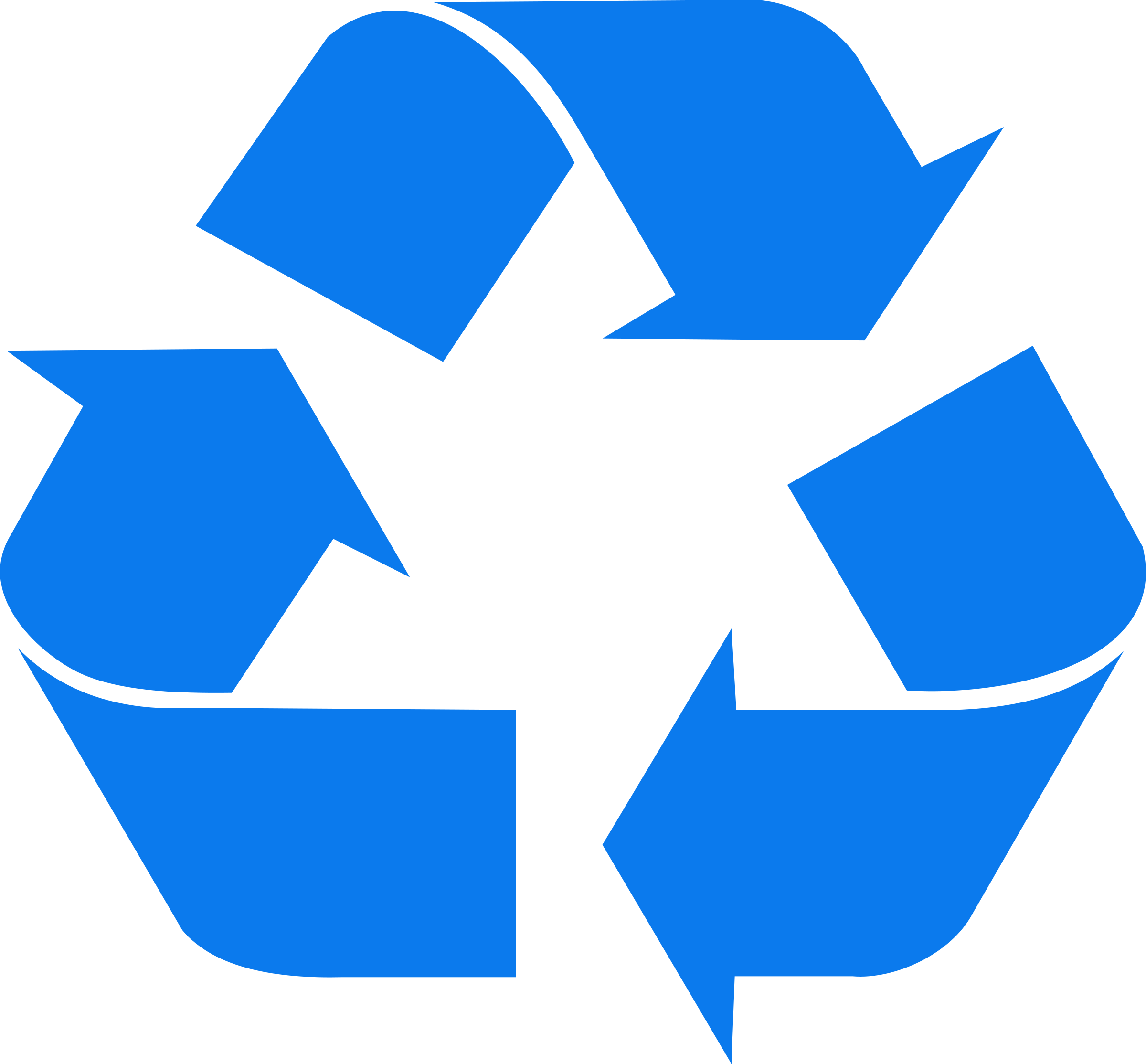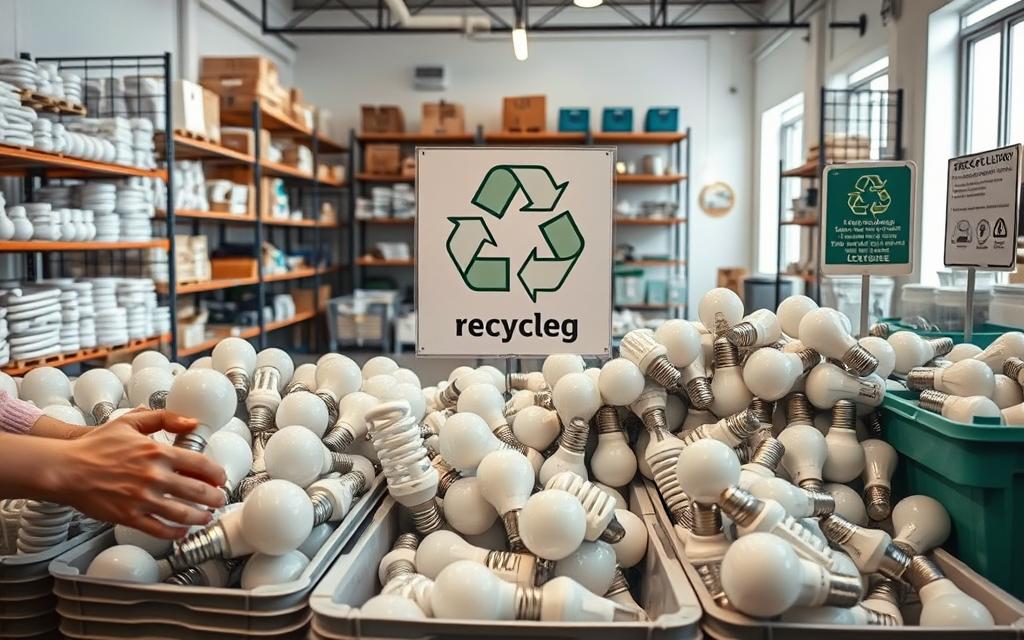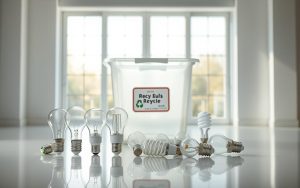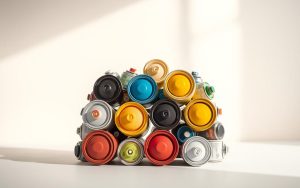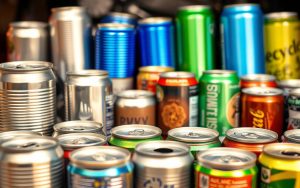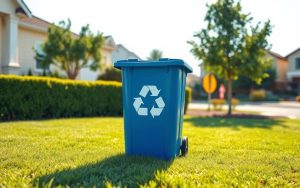Proper disposal of light bulbs is becoming increasingly important for eco-conscious households. Many types of bulbs, such as CFLs, contain mercury, which poses serious environmental and health risks if not handled correctly. Improper disposal can lead to contamination and other hazards.
There are several types of bulbs, including incandescent, halogen, and LED, each requiring specific disposal methods. Regional rules vary, so it’s essential to check local guidelines. The EPA provides recommendations, and many retailers like The Home Depot and Lowe’s offer recycling programs.
Understanding the risks and proper methods ensures safety and compliance. By following these guidelines, you contribute to a healthier environment and avoid potential legal issues.
Why Proper Disposal of Light Bulbs is Essential
The way we handle used lighting products has a significant impact on our planet. Improper disposal can lead to severe environmental and health risks. Many materials in these items, such as mercury, pose long-term hazards if not managed correctly.
The Environmental Impact of Improper Disposal
When lighting products end up in landfills, they release harmful substances into the environment. For example, CFLs contain mercury, which can contaminate groundwater. Just one bulb can pollute up to 6,000 liters of water, making it unsafe for drinking and agriculture.
LEDs, while energy-efficient, contain lead and arsenic. These toxic elements persist in landfills for decades, leaching into soil and water. Proper disposal ensures these materials are safely managed, reducing their environmental footprint.
Safety Concerns for Humans and Animals
Broken glass from lighting products injures thousands of waste workers annually. OSHA data shows over 12,000 injuries each year due to improper handling. Pets are also at risk, as mercury vapor from broken CFLs can harm their health.
In some states, illegal disposal of these items can result in fines up to $500. Following EPA cleanup protocols for broken bulbs is essential to protect both people and animals. Proper disposal not only safeguards health but also ensures compliance with local regulations.
How to Prepare Light Bulbs for Disposal
Taking the right steps to manage used lighting materials prevents hazards. Proper preparation ensures safety and compliance with environmental guidelines. Whether handling intact or broken bulbs, following specific procedures minimizes risks.
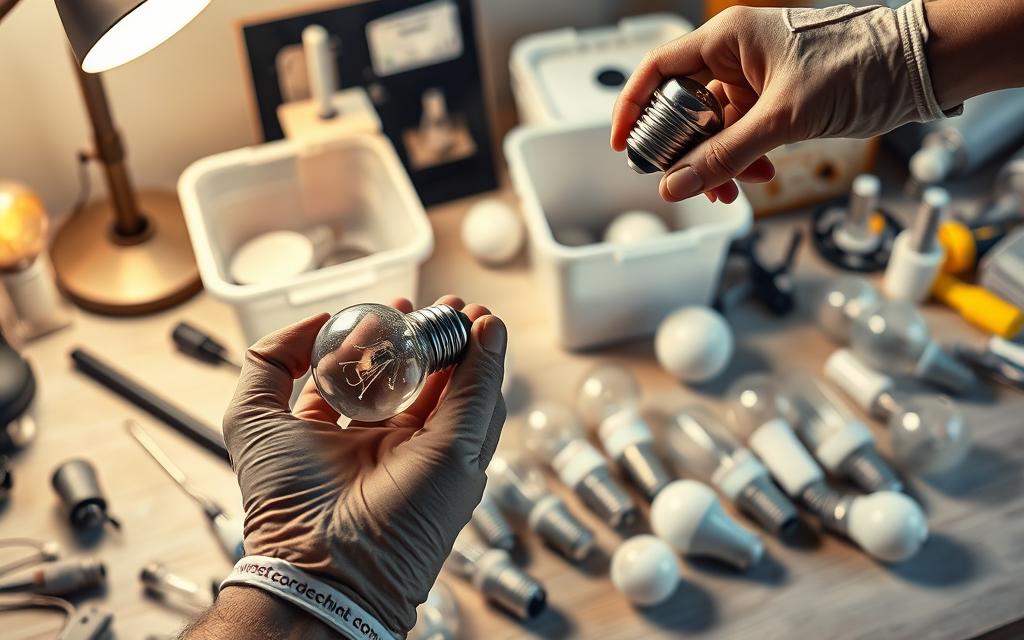
Handling Intact Bulbs Safely
For intact bulbs, place them in a plastic bag or their original packaging. This prevents breakage during transport. Retailers like The Home Depot often require bulbs in their original containers for recycling services.
Use a ziplock bag for added protection. Label the package with “Handle Carefully” to alert handlers. This simple step ensures safe transit to recycling centers.
Cleaning Up Broken Bulbs
If a bulb breaks, act quickly to minimize exposure. The EPA recommends evacuating the room for 15 minutes to avoid inhaling mercury vapor. Turn off HVAC systems to prevent spreading toxic particles.
Wear gloves and use damp paper towels to collect debris. Place all materials in an airtight container. Never use a vacuum, as it can spread hazardous particles.
| Step | Action |
|---|---|
| 1 | Evacuate the room for 15 minutes. |
| 2 | Turn off HVAC systems. |
| 3 | Wear gloves and use damp paper towels. |
| 4 | Place debris in an airtight container. |
| 5 | Label the container “Mercury – Handle Carefully.” |
Where to Dispose of Light Bulbs
Finding the right place to manage used lighting materials is crucial for environmental safety. Knowing your options ensures compliance with local regulations and protects the planet. From local recycling centers to retailer programs, there are several ways to handle this responsibly.
Local Recycling Centers
Many communities offer collection points for used lighting products. Websites like Earth911.com list over 11,000 U.S. drop-off locations. The EPA’s “Light Bulb Recycling Locator” is another excellent tool to find nearby centers. Always check state-specific rules, as regulations vary widely.
Retailer Recycling Programs
Major retailers often provide convenient programs. For example, 89% of Home Depot stores accept CFLs. Lowe’s accepts all types of bulbs, while IKEA focuses on CFLs. Batteries Plus offers fee-based services, and mail-back options like EcoLights and BulbCycle are available for bulk disposal.
Municipal Hazardous Waste Facilities
These facilities are designed to handle toxic materials safely. In 74% of U.S. counties, they operate on the first Saturday of each month. Items like CFLs and fluorescent tubes are accepted here, ensuring proper management of hazardous components. Always verify local schedules and guidelines before visiting.
“Proper disposal starts with knowing where to take your used lighting products. It’s a small step that makes a big difference.”
For more details on local rules and disposal options, visit Lowe’s comprehensive guide. By choosing the right disposal method, you contribute to a cleaner, safer environment.
How to Dispose of Incandescent Light Bulbs
Managing incandescent lighting materials requires specific steps for safety and compliance. These items are 98% non-recyclable, making proper handling essential. Whether disposing of them or repurposing, following guidelines ensures minimal environmental impact.
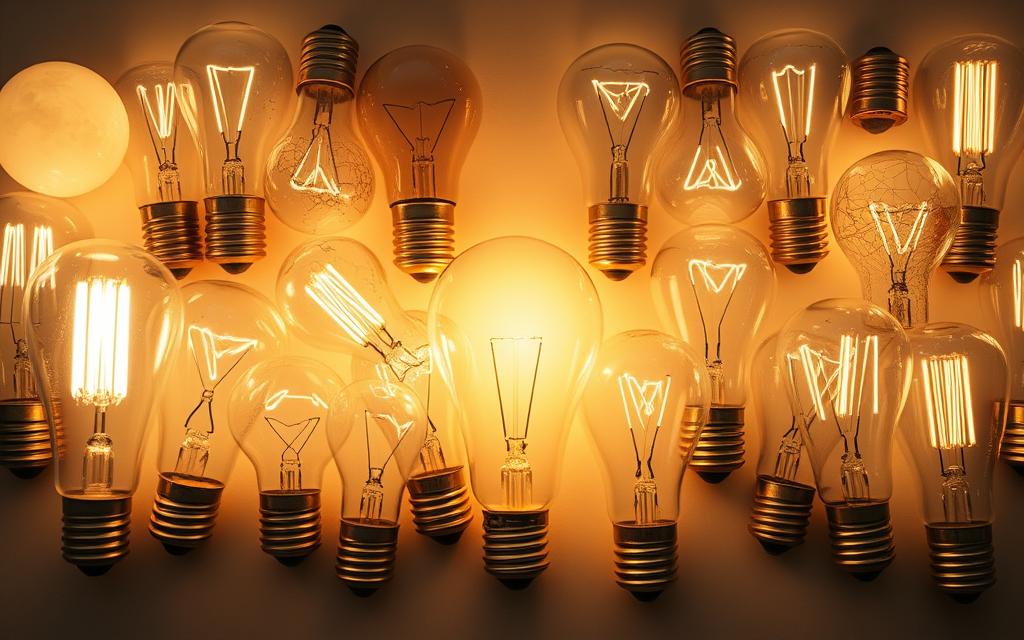
Throwing Away Incandescent Bulbs
Incandescent products can be placed in regular trash in most areas. However, precautions are necessary to prevent injuries. Wrap them in newspaper or use a double-bagging technique with paper inside plastic grocery bags.
Some states enforce weight limits, allowing a maximum of 10 items per household monthly. Always check local regulations to avoid fines. Proper disposal protects waste workers and reduces hazards.
Upcycling Incandescent Bulbs
Creative reuse offers a sustainable alternative to throwing these items away. DIY projects like terrariums, oil lamps, and Christmas decorations are popular. Michaels’ holiday ornament workshops provide inspiration for crafting.
For safety, use bulb-emptying kits like the Pro-Ject 54962 when repurposing. This ensures the glass is handled carefully. Upcycling not only reduces waste but also adds a unique touch to your home decor.
The 2007 Energy Independence Act phased out many incandescent products, making repurposing a meaningful way to honor their legacy. By exploring creative options, you contribute to a greener future.
How to Dispose of Halogen Bulbs
Halogen bulbs require careful handling due to their high operating temperatures and unique disposal needs. These items can reach up to 300℉, making them a potential fire hazard if not managed properly. GE recommends using their original packaging for safe disposal, which helps prevent breakage and reduces risks.
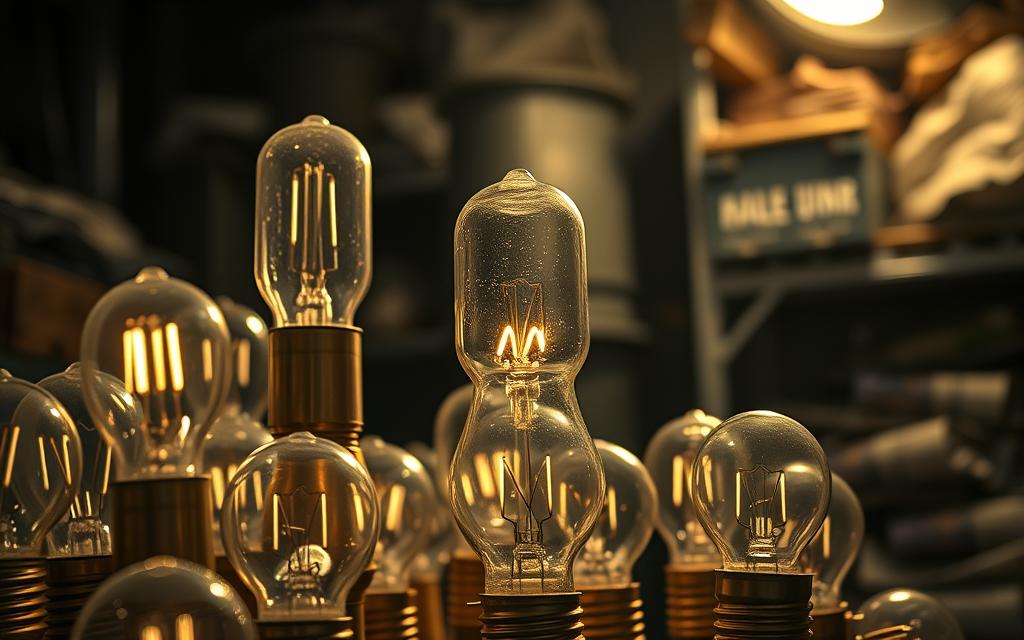
Safe Disposal Methods
When handling halogen bulbs, safety is paramount. Always allow them to cool completely before touching. Wrap them in newspaper or place them in a sturdy container to avoid injuries. For headlight bulbs, many auto parts stores like O’Reilly and AutoZone accept them for proper waste management.
Improper storage can lead to accidents. A 2018 NFPA report linked 412 fires to incorrect handling of these items. Always follow manufacturer guidelines and local regulations to ensure safety.
Recycling Options
While halogen bulbs are often thrown away, recycling is a more eco-friendly option. Specialty recyclers like LampRecycle.org offer services for a small fee, typically $2.50 per bulb. This ensures hazardous materials are managed responsibly.
Differences between EU and US standards, such as RoHS compliance, can affect disposal methods. Always check local guidelines to stay compliant. Additionally, theater lighting companies often refurbish these items, providing a sustainable reuse option.
- Auto parts stores accept headlight bulbs for disposal.
- Specialty recyclers charge a small fee for safe handling.
- RoHS compliance varies between regions, affecting disposal rules.
- Reuse potential exists in industries like theater lighting.
How to Dispose of CFL Bulbs
CFLs, or compact fluorescent lamps, require special attention when it comes to disposal. These energy-efficient bulbs contain mercury, a toxic substance that poses serious risks if not handled properly. Throwing them in the trash can lead to environmental contamination and legal penalties.
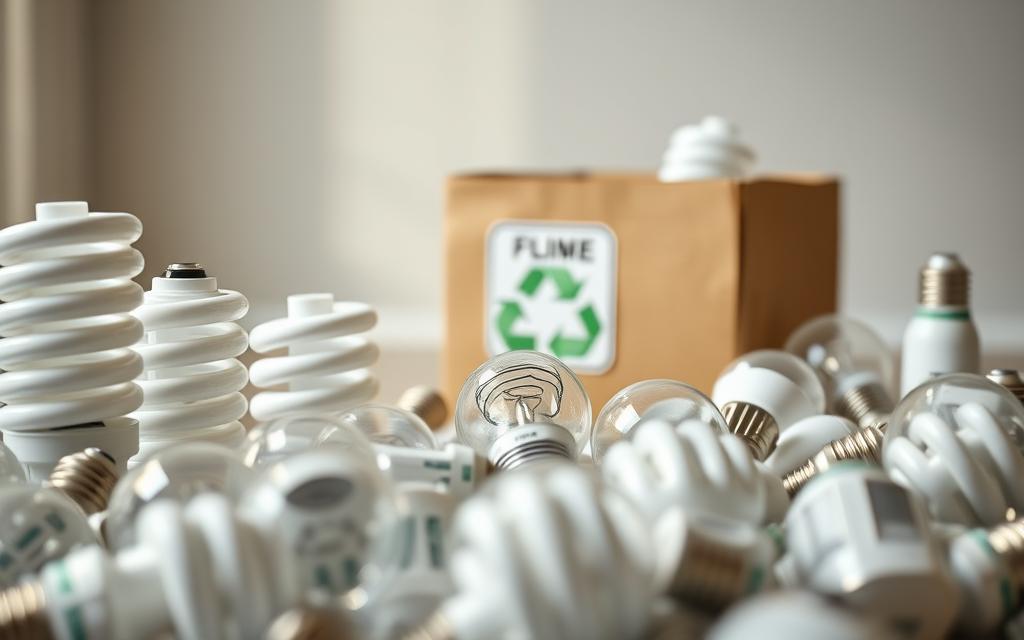
Why CFLs Should Not Be Thrown in the Trash
Improper disposal of CFLs can release mercury into the environment. This toxic element contaminates soil and water, harming ecosystems and human health. In Massachusetts, for example, illegally discarding these bulbs can result in fines up to $10,000.
Facilities like Veolia recover 99.8% of mercury from CFLs, ensuring safe management. This highlights the importance of using proper disposal methods. By following guidelines, you protect both the planet and yourself from potential hazards.
Retailer and Mail-Back Recycling Programs
Many retailers offer convenient recycling programs for CFLs. Ace Hardware charges a nominal fee of $0.99 per bulb, making it an affordable option. Brands like Philips and EcoSmart also partner with recycling initiatives to promote sustainability.
For those without access to local drop-off points, mail-back services are available. Companies like EcoLights and BulbCycle provide kits for safe shipping. These programs ensure hazardous materials are managed responsibly.
| Retailer | Recycling Fee |
|---|---|
| Ace Hardware | $0.99 per bulb |
| Philips | Free with partnership programs |
| EcoSmart | Free with mail-back kits |
With the 2025 federal ban on certain CFLs, proper disposal is more critical than ever. By utilizing these programs, you contribute to a cleaner, safer environment while complying with regulations.
How to Dispose of LED Bulbs
With 95% recyclable components, LED bulbs offer a sustainable disposal solution. These energy-efficient products contain trace amounts of heavy metals, such as lead and arsenic, which can harm the environment if not managed properly. Proper waste collection ensures these materials are safely recovered and reused.
Recycling LED Bulbs
Recycling is the preferred method for disposing of LED bulbs. Major retailers like Best Buy and Staples offer free programs, making it convenient for consumers. The process involves shredding the bulbs and separating components like glass, plastic, and metals. This not only reduces landfill waste but also recovers valuable resources.
Intel’s urban mining initiative focuses on microchip recovery from discarded electronics, including LED bulbs. This innovative approach reduces the need for raw materials and supports a circular economy. Additionally, recycling saves $0.87 per bulb compared to landfill fees, making it a cost-effective choice.
Why Recycling is Preferable to Trash
Throwing LED bulbs in the trash poses risks due to their metal content. Each bulb contains 0.2g of lead, equivalent to five car batteries. When improperly disposed of, these metals can leach into soil and water, harming ecosystems and human health.
- Retail programs: Staples (free), Home Depot (varies by store).
- Toxicity stats: 0.2g lead per bulb.
- Innovation: Samsung’s closed-loop LED production.
For more details on ways to recycle LED light bulbs, visit EPB’s comprehensive guide. By choosing recycling, you contribute to a cleaner, safer environment while conserving valuable resources.
How to Dispose of Fluorescent Tubes
Fluorescent tubes demand careful handling due to their unique composition. These lighting products contain mercury, a hazardous material that requires specific disposal methods. Improper management can lead to environmental contamination and health risks.
Special Handling Requirements
Fluorescent tubes, especially 4-foot ones, contain up to 12mg of mercury. This makes them fragile and potentially dangerous if broken. According to DOT 49 CFR 173.34, specific packaging is required for safe transportation. Protective eyewear is also recommended to shield against UV exposure during handling.
Breakage during disposal is a common issue, with 18% of tubes breaking unintentionally. To minimize risks, use sturdy containers and avoid stacking tubes. Commercial solutions like WM’s LampTracker system ensure safe collection and processing.
Finding Local Recycling Programs
Many communities offer local waste programs for fluorescent tubes. Nonprofits like Habitat ReStore accept working tubes for reuse. Retailers like Grainger provide bulk pickup services, making it easier for businesses to manage large quantities.
- Check local guidelines for drop-off locations.
- Use Earth911.com to find nearby recycling centers.
- Consider mail-back programs for convenience.
“Proper disposal of fluorescent tubes protects both the environment and public health.”
By following these steps, you ensure safe and compliant disposal of fluorescent tubes. This not only reduces environmental impact but also supports sustainable waste management practices.
Conclusion
Understanding the correct methods for handling used lighting ensures safety and environmental protection. Each type of bulb, from incandescent to fluorescent, has unique disposal requirements. Always check local guidelines to ensure compliance with regional rules.
Bookmark the EPA’s recycling programs for easy access to updated information. Consider ENERGY STAR-certified replacements for a more sustainable choice. For immediate assistance, call the national hotline at 1-800-CLEANUP.
Remember, the 2025 CFL ban is approaching. Proper disposal now helps avoid future complications. By choosing the right options, you contribute to a cleaner, safer planet.
